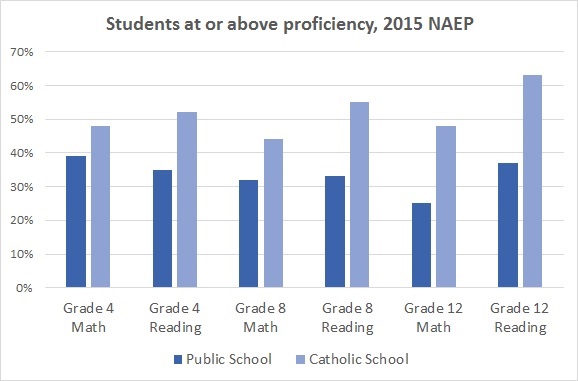by Renée Stoeckle
Earlier this month, the results of the Nation’s Report Card showed Catholic school students once again outperforming their public school peers in both reading and mathematics.
The report, which biannually compares achievement of fourth-, eighth-, and twelfth-graders in public, non-public and private schools across the US, is widely considered to be the most consistent measure of student achievement in the United States.
The gaps between Catholic school students and their public-school peers grow wider for the oldest students. By twelfth grade, the differences are staggering: 63 percent of Catholic school seniors perform at or above proficiency in reading, compared to 37 percent of public school seniors. Similarly, 48 percent of Catholic school seniors perform at or above proficiency in math, compared to 25 percent of public school seniors.

What is it about Catholic schools that leaves their seniors performing so much higher than their public-school peers, year after year?
One possible explanation may lie with what a team of social scientists notoriously termed the “Catholic school effect.” In the early 1980s, a research team led by Andrew Greeley and James Coleman found that students attending Catholic high schools gained between 0.8 and 1.7 grade-equivalents more than their public-school peers between their sophomore and senior years.
In the decades since they issued their High School and Beyond report, public schools have steadily closed their performance gap with private schools, especially with younger students, whose achievement is subject to greater scrutiny in most school accountability systems.
Still, the wider gaps for older students on the latest National Assessment of Educational Progress, in which results for all 12th graders nationally were largely flat, recalls Coleman and Greeley’s findings at a time when many educators are looking for better ways to keep students engaged through their final years of high school.
NAEP considers itself “the largest nationally representative and continuing assessment of what American students know and can do in various subject areas.” And it is, but it doesn’t allow for true comparisons of school effectiveness. The test measures proficiency rather than learning gains, and does not control for differences in student characteristics that may be an important factor in the results.
The jump in performance in the later grades isn’t entirely surprising, as Catholic schools tend to be more selective as students get older. Tuition costs more than double between eighth and ninth grade, and many schools require entrance exams of high school students. But there’s more to the story than that, as the benefits of the Catholic school effect apply to students across all income levels and ability levels.
In their 1982 study, Coleman and Greely cited a series of factors that contribute to the Catholic school effect, including students in Catholic schools spending more time on homework and having fewer discipline issues, like fighting, absenteeism and disrespect for authority, than their public school counterparts.
More than that, High School and Beyond credits the vigorous academic coursework associated with Catholic high schools, including the often-extensive core curriculum and academic tracking. Those factors are still present today, and they may deserve more attention as policymakers look for ways to make the final years of high school – when most American public-school students are no longer required to take statewide standardized tests – more rigorous and relevant.
In looking at the graduation requirements across Florida, Catholic schools require students to complete on average 3.8 more credits than public schools do for a standard high school diploma, though exact requirements vary by school. All of Florida’s Catholic high schools require 4 credits of theology and at least 2 credits of world language to be taken in consecutive years. And while students in both public and Catholic high schools in Florida are required to take roughly the same number of science and social studies credits (public school 3 and 3, Catholic school 3 and 3.5), most Catholic high schools require a strict course sequence, including mandatory physics, biology and chemistry in the natural sciences and world history, civics, government and economics in social studies.
Students in Florida’s public high schools have a broad course selection to choose from, and they should, given their 8 credit hours of elective courses. In Catholic high schools, however, the course selection is limited by personnel and resources. The average student takes fewer than than 4 credit hours of elective courses over their four years.
Of course, how students use their elective course credits can greatly impact learning outcomes. Students in Florida public schools can earn a Scholar Diploma by taking a more rigorous course load, including electing higher level math and science classes, earning two credits in world language and at least one AP, IB or dual-enrollment course. This academic track, intended for students with college ambitions, more closely resembles that of a Catholic school student.
Educators and other close observers have at times speculated that there’s something good happening in Catholic schools when it comes to reading instruction – something researchers should study more closely, and other schools could possibly emulate. Perhaps it’s worth asking a similar question about Catholic high schools. Are they particularly good at combating junior- and senioritis, and if so, why? Is it the academic foundation their students build in earlier years? The required course load? Something else? The answer to these questions could help high schools better prepare students for success in college, and that makes them worth exploring.


